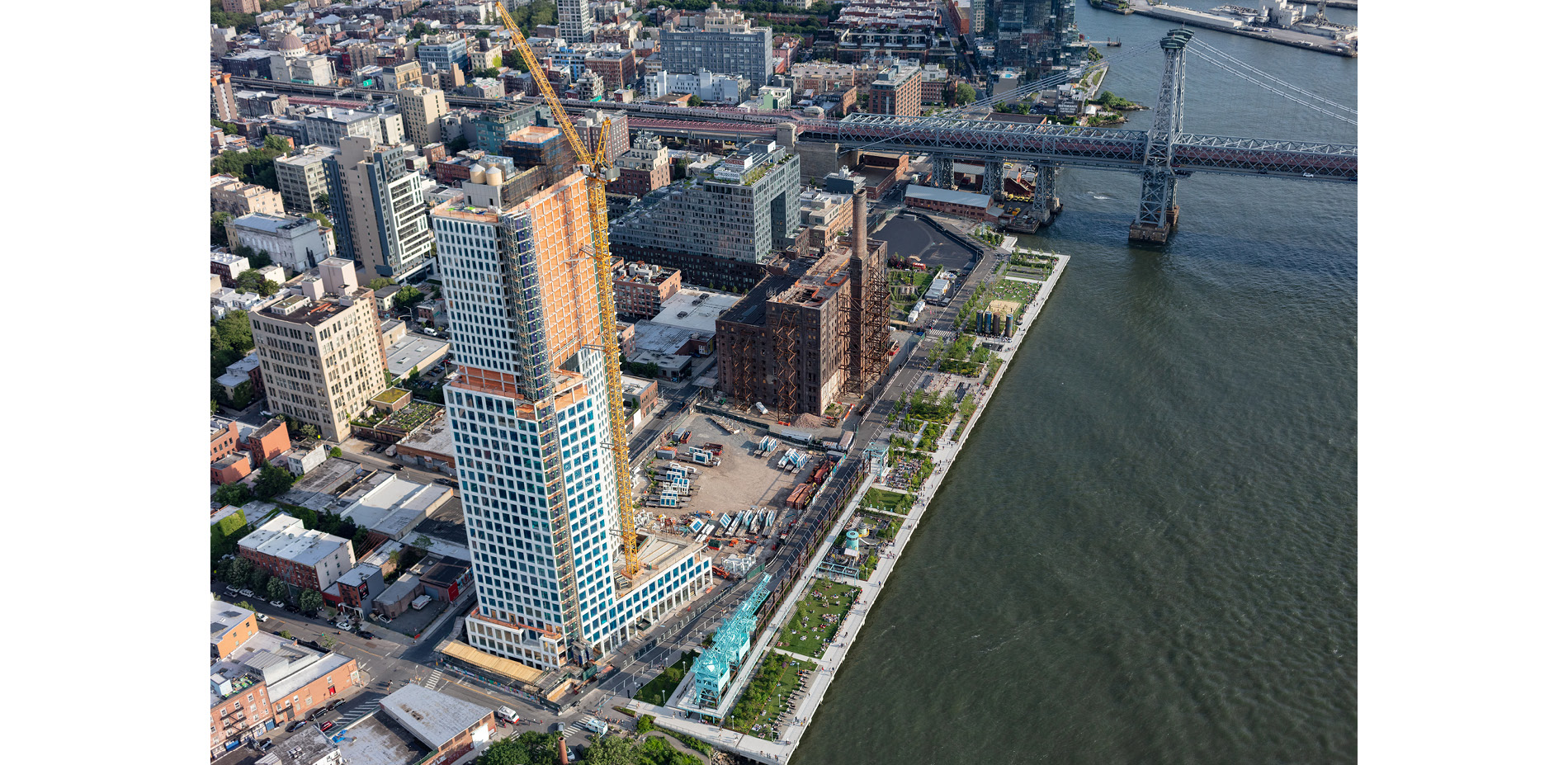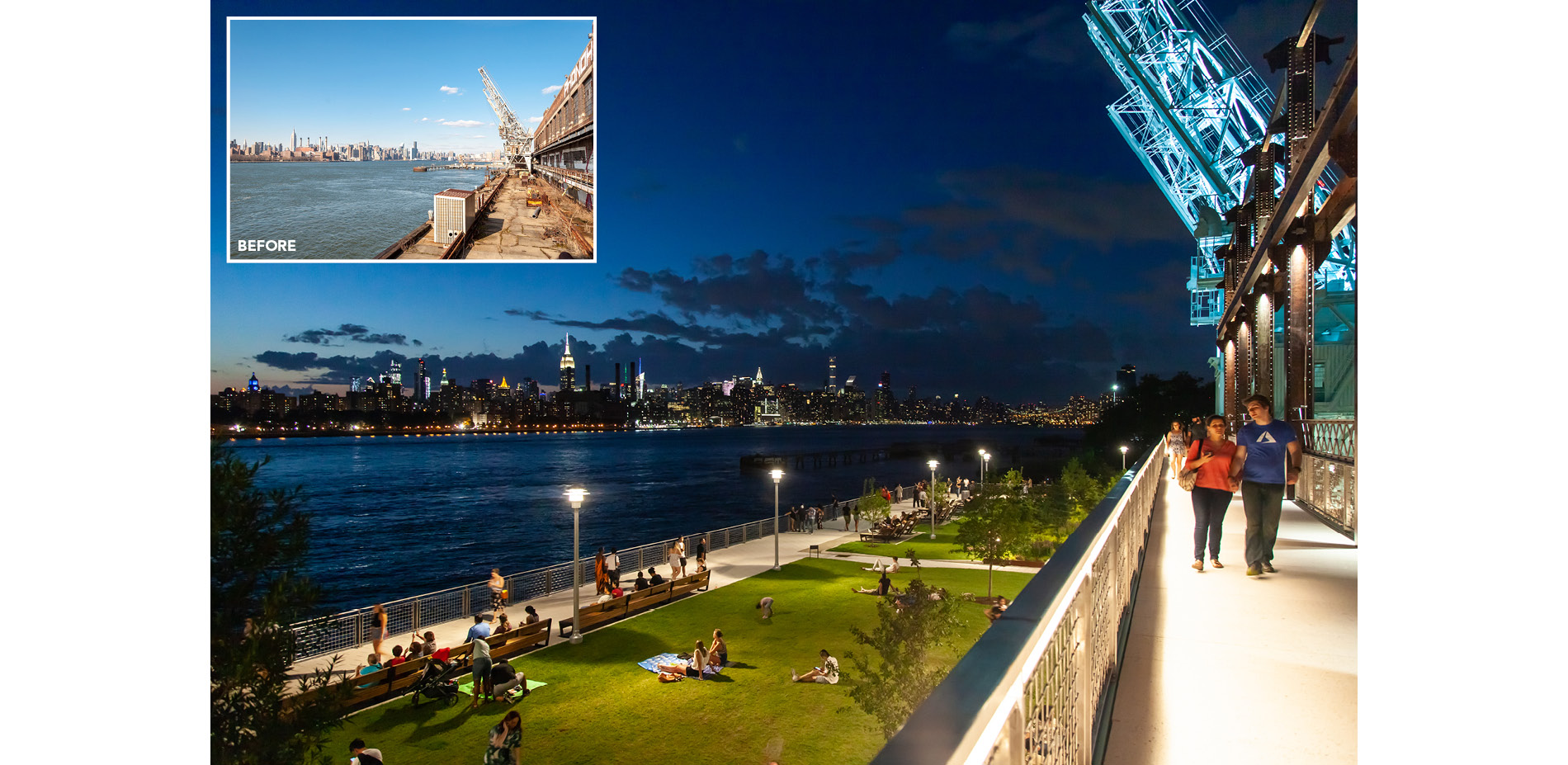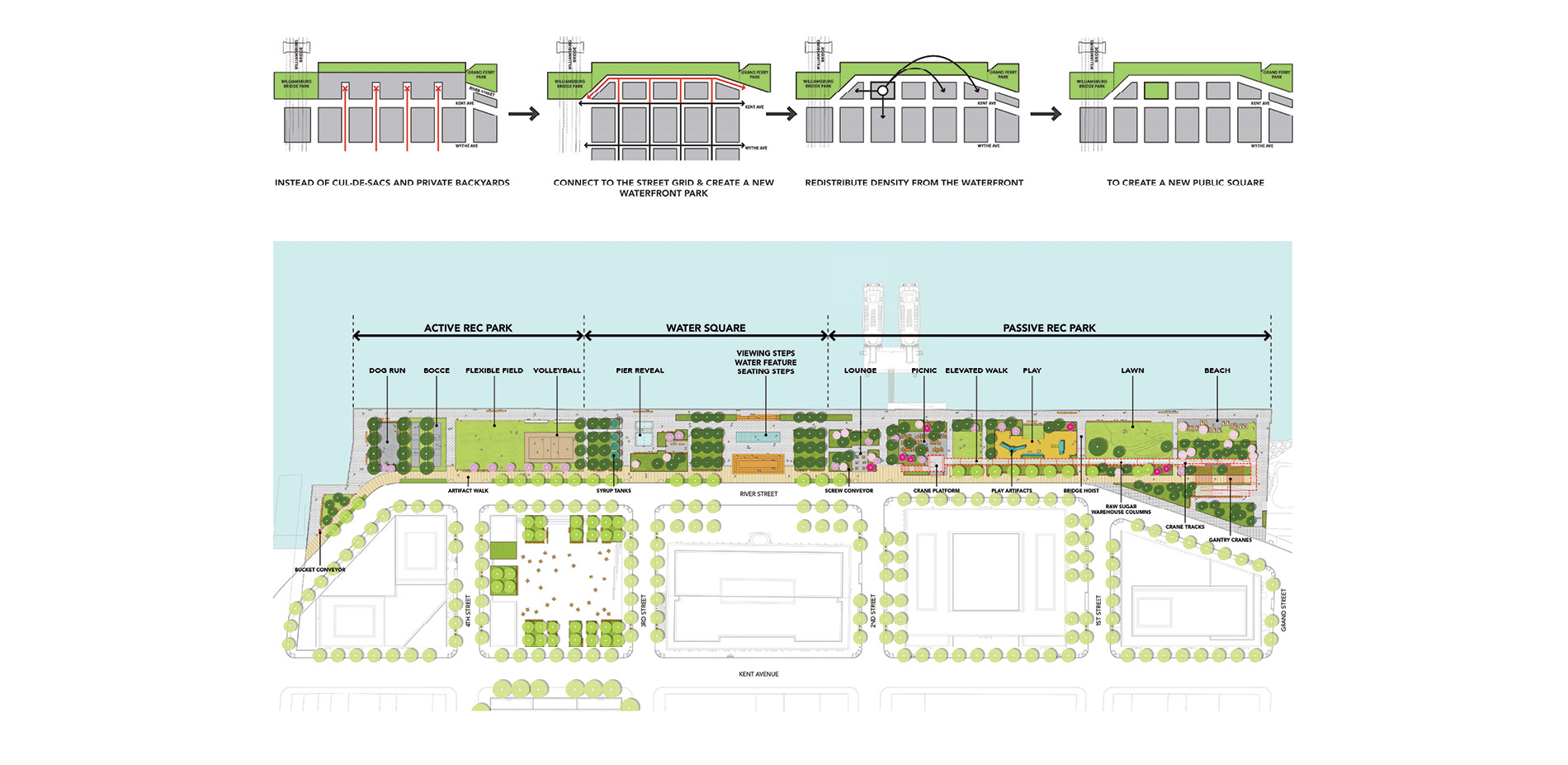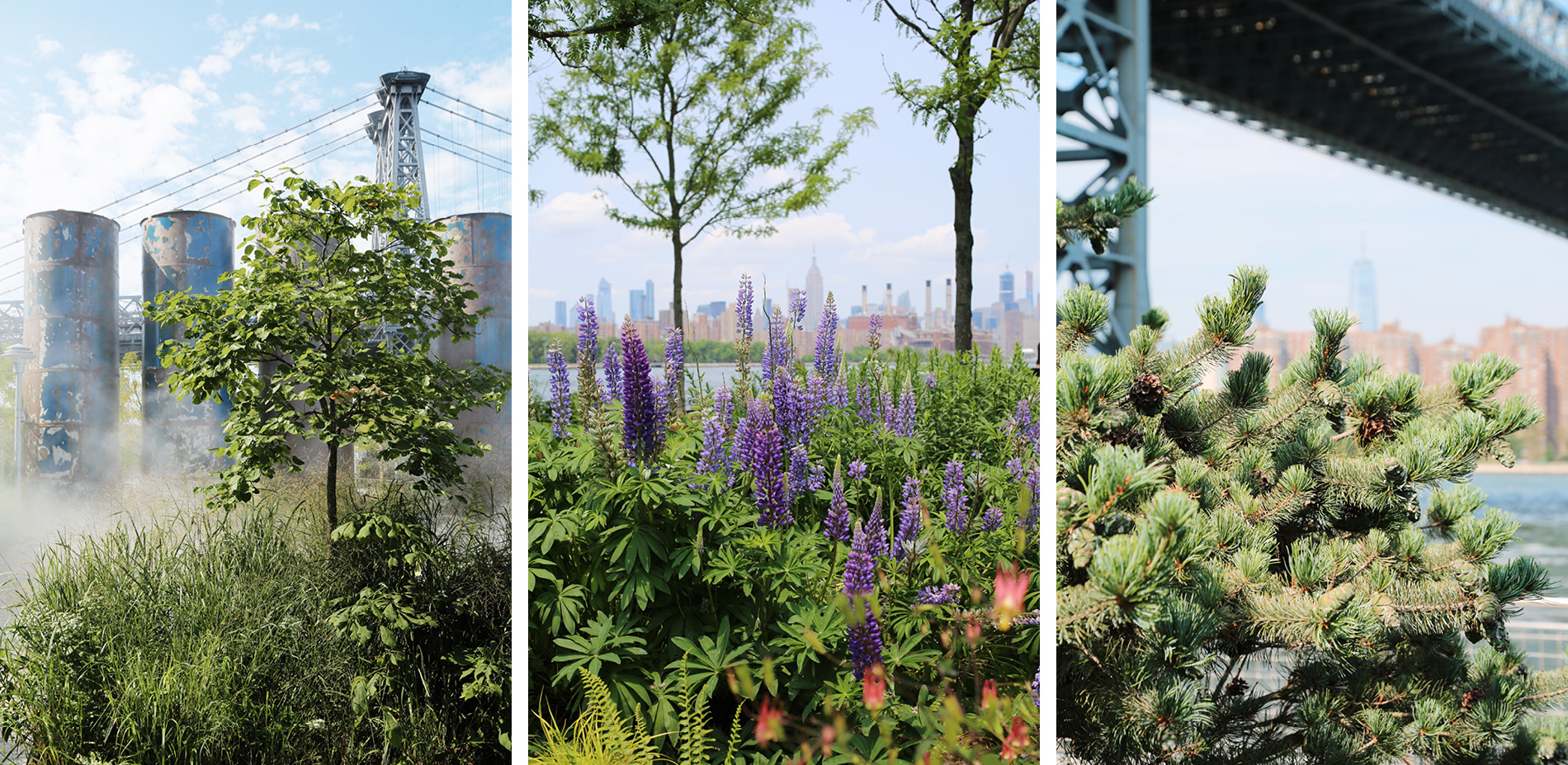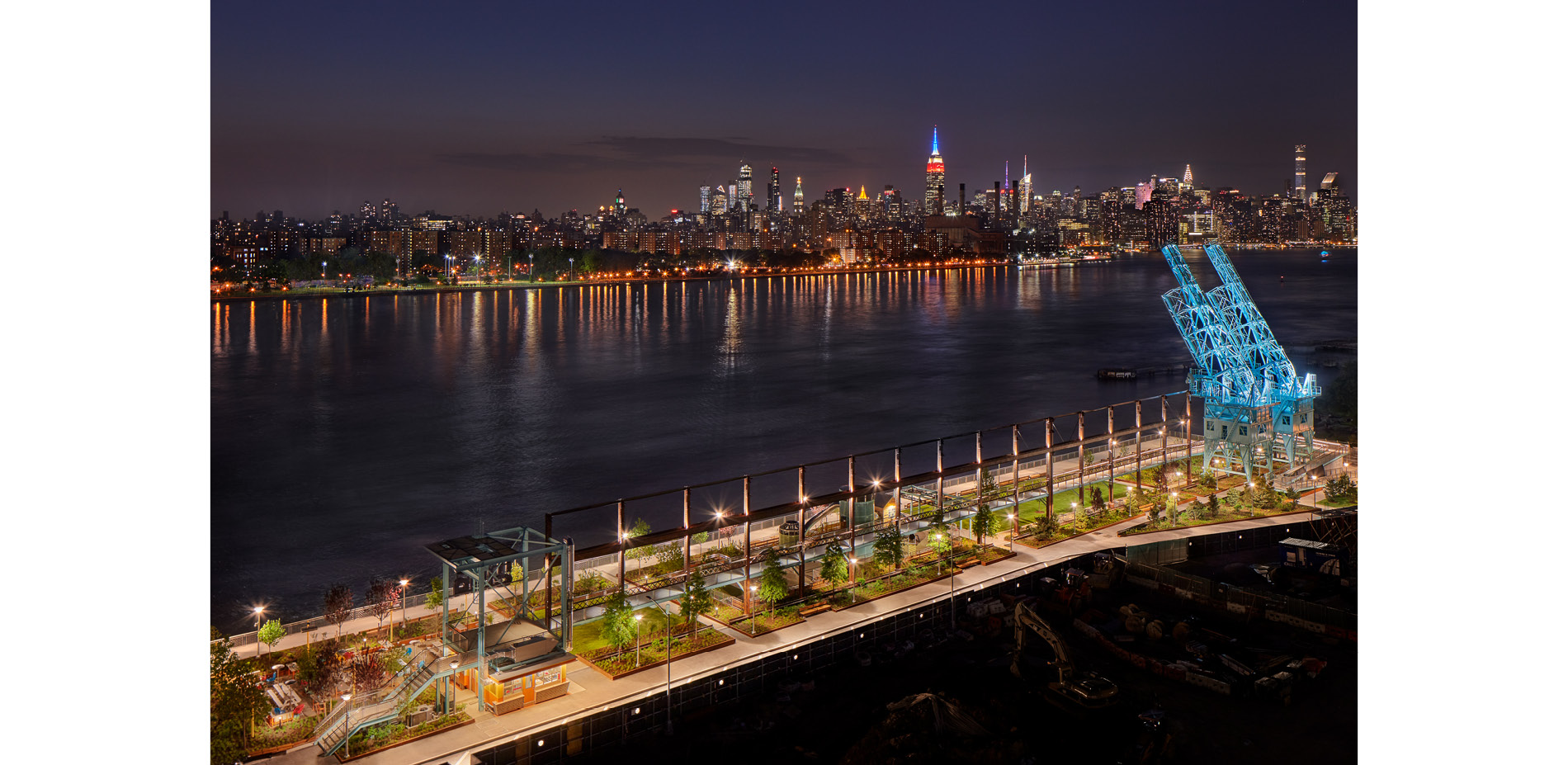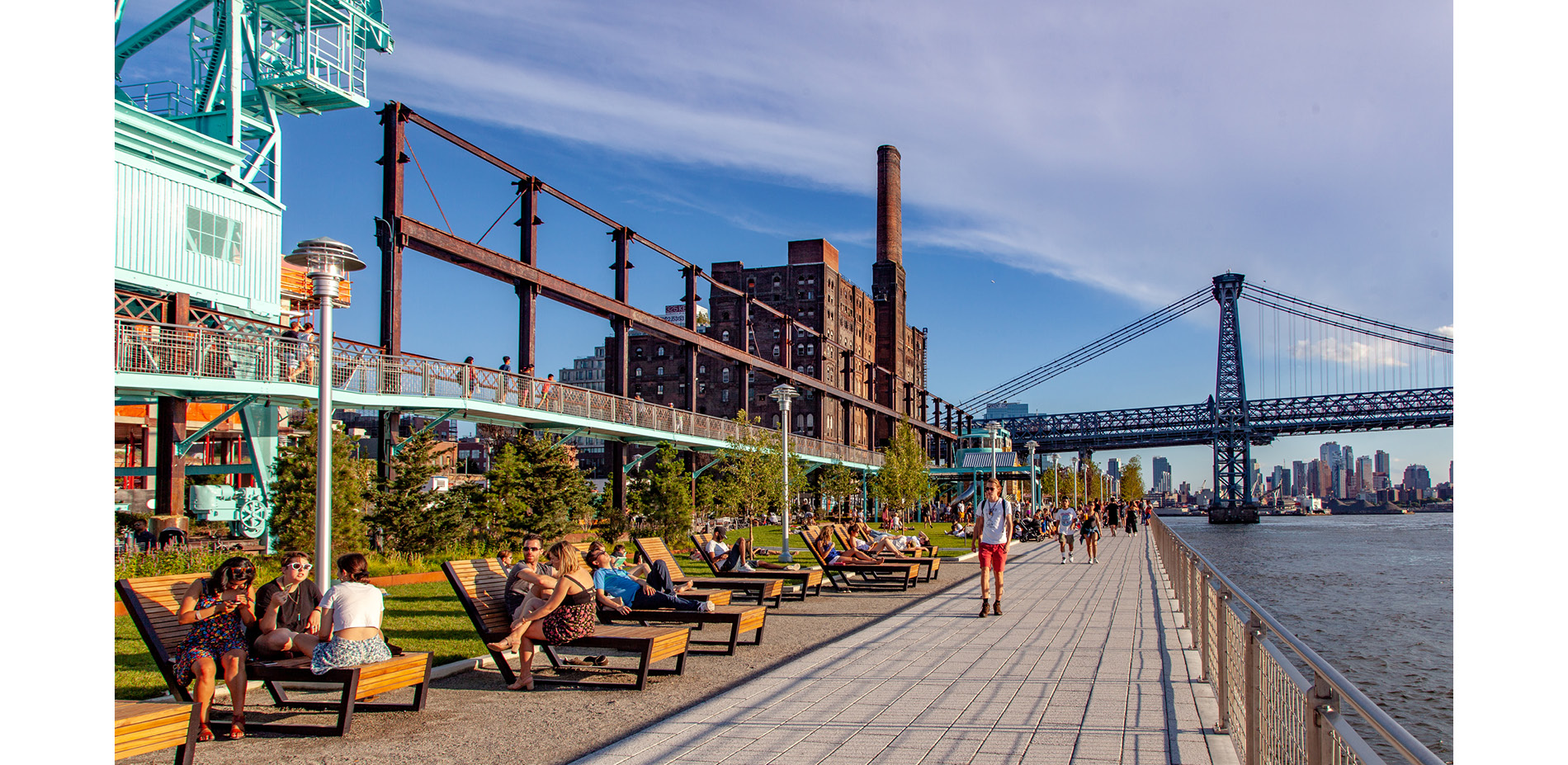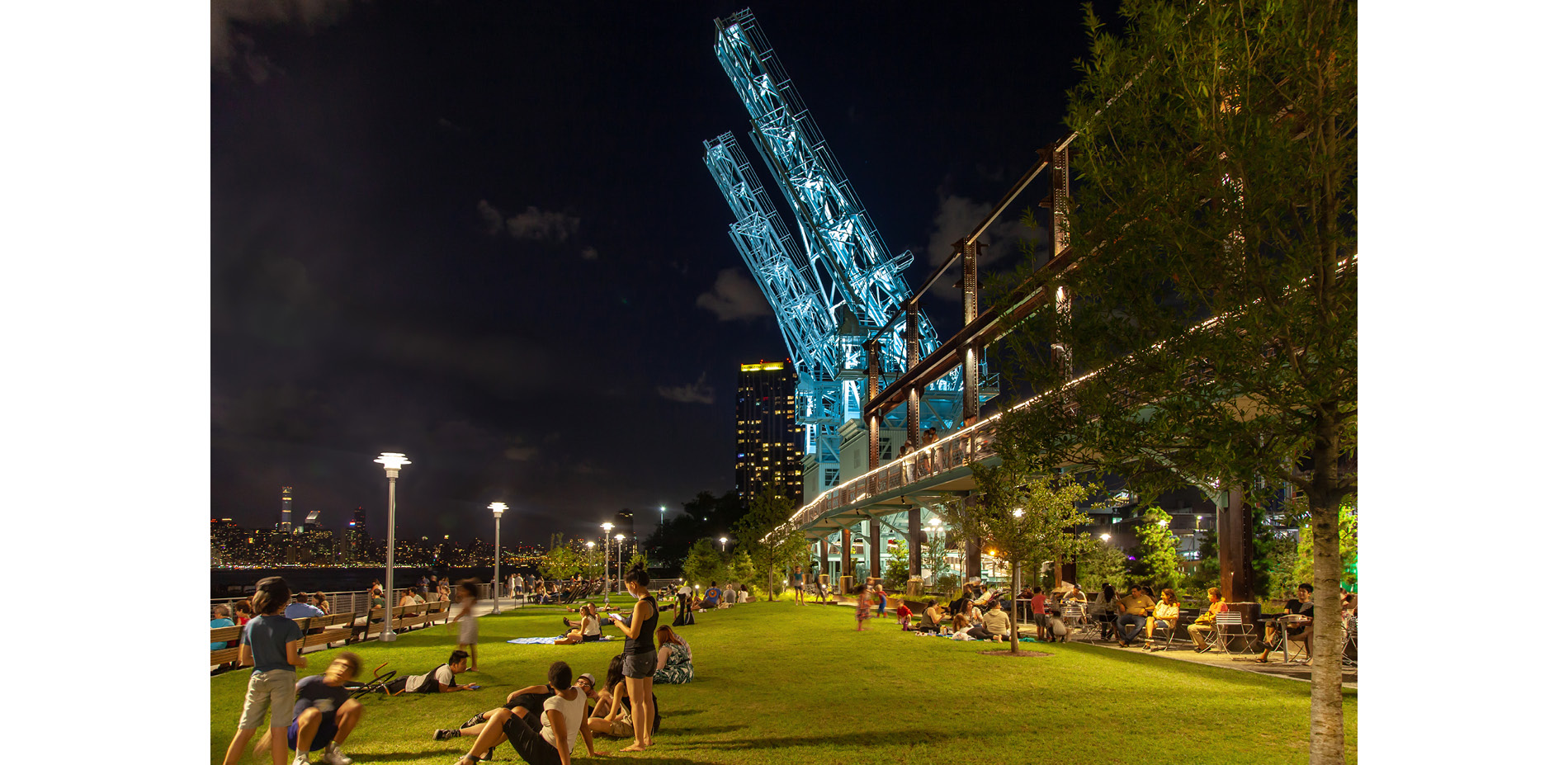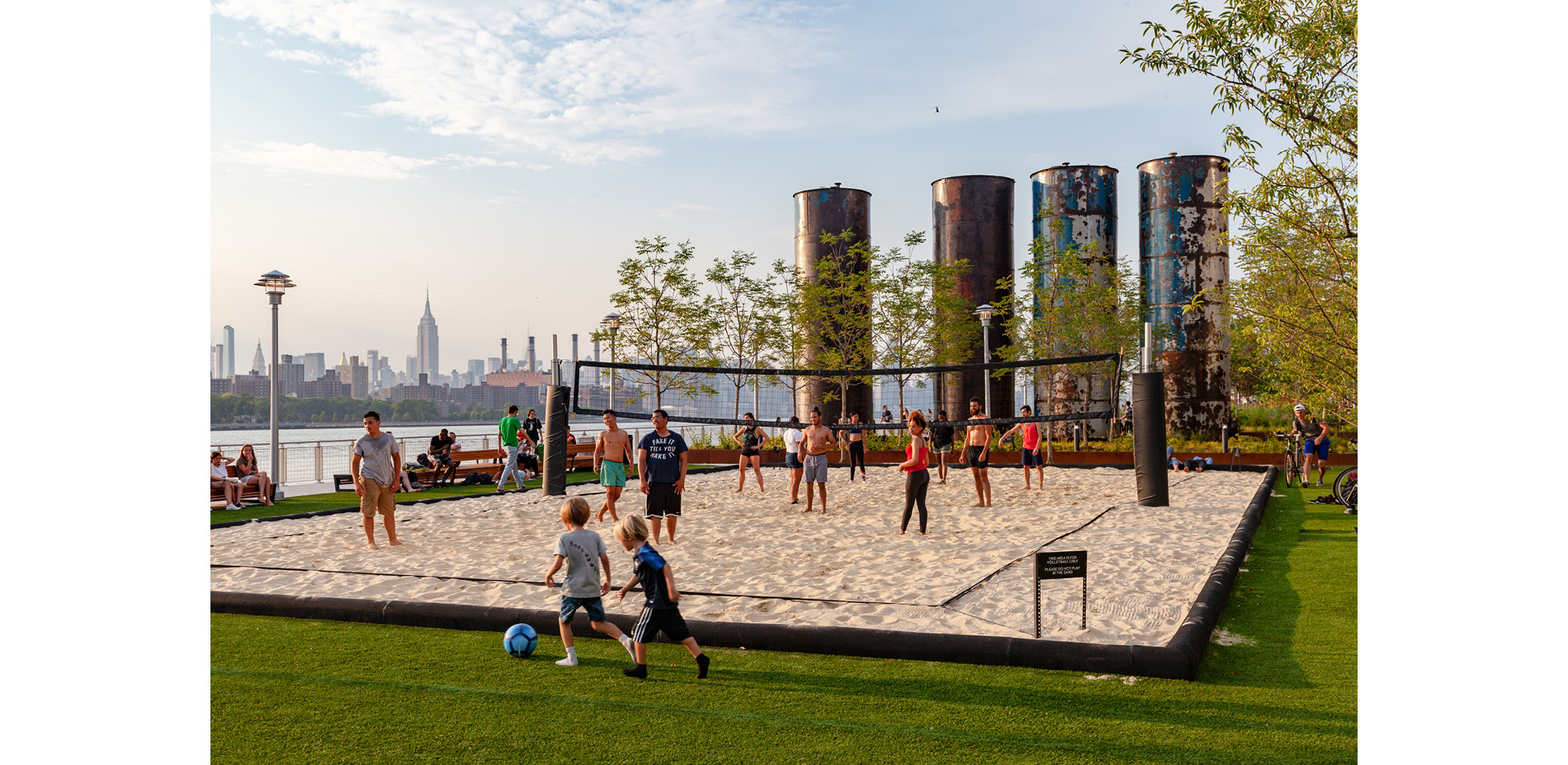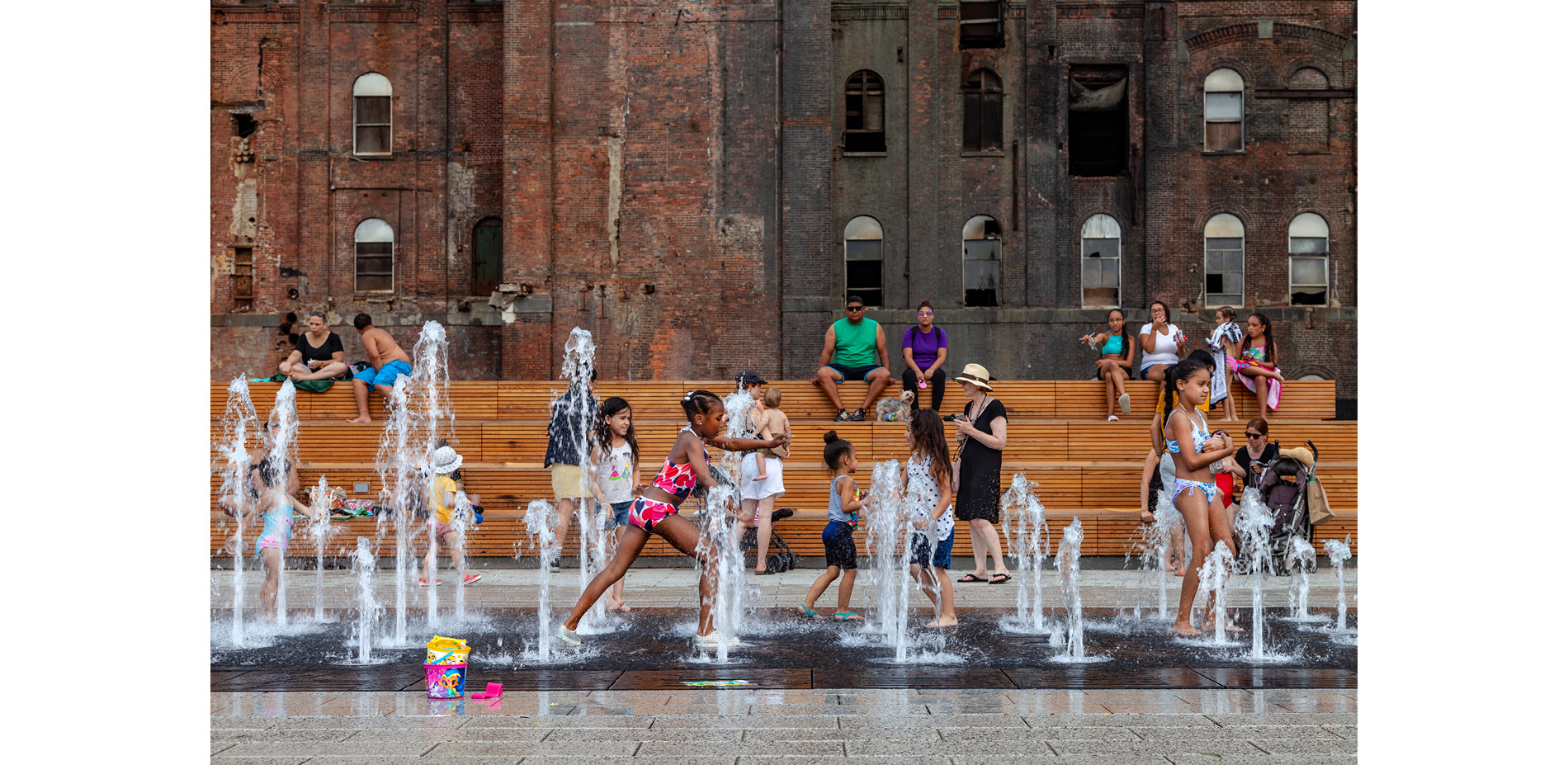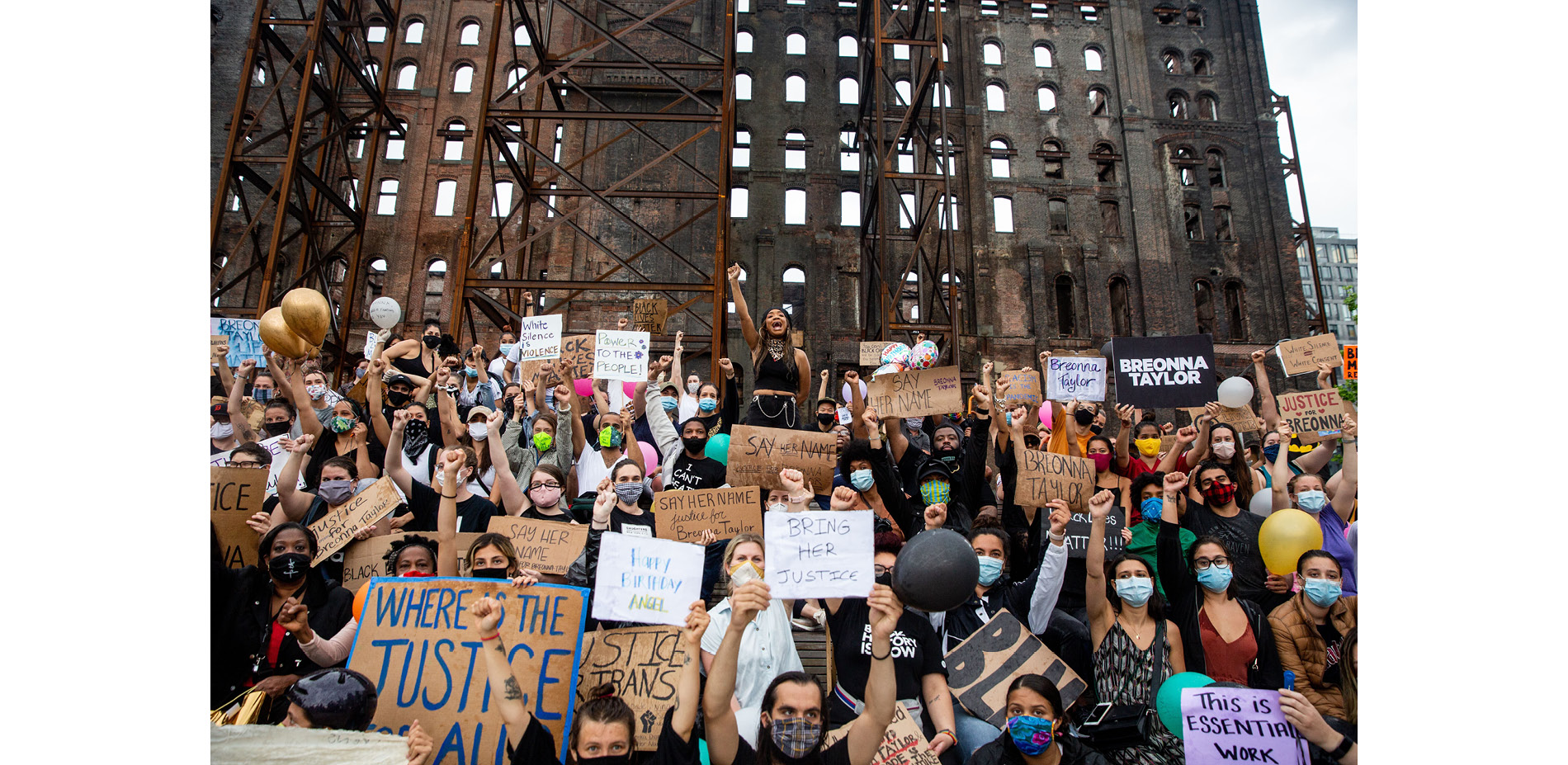Domino Park
Honor Award
General Design
Brooklyn, New York, United States
James Corner Field Operations
Client: Two Trees Management
The 5-acre riverfront park showcases the history of an iconic industrial waterfront site by integrating over 30 large-scale salvaged relics into an educational “Artifact Walk.” The artifacts include 21 original columns from the Raw Sugar Warehouse, gantry cranes, screw conveyors, bucket conveyors and syrup tanks. Native plant species reduce stormwater runoff. The jury appreciated how “the old infrastructure was given new life with the insertion of so many different types of public forums and landscapes.”
- 2022 Awards Jury
Project Credits
Two Trees Management, Client
James Corner Field Operations, Design Lead, Landscape Architecture, Master Planning
SHoP Architects (with Vishaan Chakrabarti), Master Plan Architecture Lead
Philip Habib & Associates, Civil Engineer
McLaren Engineering Group, Marine Engineer
Silman, Site Structural Engineer
Altieri Sebor Wieber LLC, Site MEP Engineer
Soucy Aquatik, Water Feature Designer
Noë & Associates, Identity, Wayfinding, Signage
Mark Reigelman, Playground Artist
Teri Hendy, Site Masters, Inc, Play Safety Consultant
Lighting Workshop, Lighting Designer
Craul Land Scientists, Soil Science
Northern Designs, Irrigation
Kelco, Landscape Contractor
Project Statement
Domino Park is the first phase of the transformation of the former Domino Sugar Factory site into an ambitious mixed-use development project, sited within an area with one of the lowest ratios of open space to people.
Inspired by community input and the site’s rich history, the 5-acre Domino Park reconnects Williamsburg to the East River for the first time in 160 years and provides much-needed open space for local residents while honoring its history as a working waterfront. The park integrates over 30 large-scale salvaged relics, including 21 original columns from the Raw Sugar Warehouse, gantry cranes, screw and bucket conveyors, and syrup tanks into an interpretive and educational “Artifact Walk.” Raised above FEMA flood elevations with many native plant species that reduce stormwater runoff, the park also functions as an absorbent sponge and first line of defense against sea level rise.
Domino Park has seen over 4 million diverse visitors from nearby Latino, Hasidic, and Black communities and hosted hundreds of events and gatherings for local organizations.
Project Narrative
Industrial Legacy
Domino Park is built on the former Domino Sugar Refinery, a site of incredible significance to the growth and development of the Williamsburg neighborhood and Brooklyn waterfront on the East River. It was once the largest and most productive sugar refinery in the world, producing up to 98% of the sugar consumed in the United States. Closing in 2004, the Refinery was the last major active industrial operation on Brooklyn’s once-bustling East River waterfront. Today, the park is a tribute to the story of this site and is dedicated to the diversity and resiliency of generations of Domino workers, their families, and their neighborhood.
Domino Park was the first built portion of the 11-acre site’s transformation into an ambitious mixed-use development project, representing a commitment to deliver public space for the surrounding community. The park reconnects Williamsburg to the East River for the first time in 160 years and provides much-needed open space for local residents, while honoring its history as a working waterfront. Combining with upcoming Two Trees’ River Ring development, Domino Park creates an integral link for a fully connected waterfront of the future. The overall project includes adaptive reuse of the landmark Refinery building for creative office space and four new mixed-use residential buildings, including 700 units of affordable housing.
Artifact Walk
One of the primary park features is an interpretive and educational “Artifact Walk,” which integrates over 30 large-scale salvaged relics that showcase the inner workings of the sugar refining process. Restored artifacts include 80-foot-tall gantry cranes and a crane platform that once unloaded sugar; syrup tanks; bucket and screw conveyors; a hoist bridge; and 21 columns from the Raw Sugar Warehouse. A 2-block-long elevated walk reinvents the catwalk experience that was distinctive of the original factory complex and provides an up-close view of the artifacts, a unique perspective from above, and views of the Manhattan skyline. It is a nexus of old and new—a trace of the past and a new social balcony.
As impressive and tactile pieces of history, the artifacts provoke a sense of wonder, discovery, and inquiry about the history of the site.
Park Experience
An important first move was the extension of River Street to reconnect the park back to the city grid and deepen a sense of publicness rather than a perception of a private front lawn for new development. The new street also significantly improves connections between the upland and the waterfront, eliminating the need for stairs and ramps and increasing the park’s accessibility.
Domino Park offers a range of activities that appeal to a diverse user group, with spaces for visitors and locals alike to come together. Active uses are clustered in the south near the Williamsburg Bridge, where there is more noise and urban context, including a dog run, bocce courts, a flexible playing field, and volleyball court. The Refinery building, with its distinctive smokestack, represents the physical and spiritual heart of the redevelopment, with features that awaken a strong connection to water. A large tiered seating feature serves as a gathering place and vantage point to view a playful interactive water feature, one which transforms into an open plaza for public gatherings when the water is turned off. The Fog Bridge spans an open cut to the river below, revealing historic timber piles and allowing visitors to see the waves and hear the sound of the tides. A set of misters surrounding the bridge emit a gentle cloud of fog that envelops passersby in the shoreline’s wind patterns, creating a dramatic entryway to the massive Syrup Tanks.
The northern part of the park is defined by the emblematic Gantry Cranes and Elevated Walk with a focus on more passive and family-oriented uses. An inventive playground designed by artist Mark Reigelman creates a fun journey through the site’s history for children. Tacocina offers a laid-back setting for tacos, beer, and cocktails enjoyed next to a large rolling lawn that provides a relaxing place to hang out and watch the sunset.
The park’s materials are inspired by the tough, industrial character of the Williamsburg waterfront including weathered, galvanized, and stainless steel, concrete, and reclaimed wood from the factory itself. A custom furniture palette constructed from reclaimed pine and powder-coated steel includes a mix of tables, lounge chairs, and benches. Original metal finishes and patinas were preserved where possible. New steel was painted a turquoise “Domino blue” to match a color found throughout the original Refinery, along with relics that needed a new finish, such as the gantry cranes and mooring bollards.
Resiliency
The project started days after Hurricane Sandy and was greatly influenced by that event and subsequent discussions in NYC regarding resiliency. One of the first decisions was to set the buildings back beyond the required distance and raise the platform to be above predicted post-Sandy FEMA flood elevations. This resulted in a more generous park while protecting the buildings and infrastructure. 43% of the park is vegetated with nearly 175 new trees and a hardy native understory that reduce stormwater runoff and function as an absorbent sponge and first line of defense for the neighborhood.
The park is one of the first projects to be certified under WEDG (Waterfront Edge Design Guidelines), an incentive-based ratings system to make waterfronts more resilient, environmentally healthy, accessible, and equitable for all. The park’s landscape is managed 100% organically, and plant material and debris from the park is composted and redistributed back into the plant beds.
Building Community
A robust grassroots community outreach effort complemented the official rezoning process, including large public forums as well as numerous small meetings with respected community groups and leaders to make sure the park reflected and served its community. The plan won widespread community board support in 2013 and has delivered fully integrated, deeply affordable units. Domino Park also has longstanding relationships with local organizations Churches United and Los Sures, as well as placement of over 100 local jobs through St. Nicks Alliance.
From day one, Two Trees and the design team held countless community charrettes to incorporate what the local residents wanted in the new park, which led to family-oriented activities, the popular volleyball and bocce courts, and a number of other programs. The relationships built in those meetings directly reflect the diverse park visitorship today.
To date, the park has seen over 4 million diverse visitors from nearby Latino, Hasidic and Black communities and hosted hundreds of events and gatherings for local organizations, including mural painting, book clubs, sketching classes, salsa, and student photography exhibitions. In June 2020, Domino Park welcomed its first community food scrap drop-offs in response to city-wide cuts and announced a partnership with the Billion Oyster Project to clean, restore, and protect the local ecosystem with Oyster Research Stations on-site.
Most recently, Domino Park has been spotlighted as a global model for open space, civil discourse, and adaptive public space. The park was able to deploy quick, effective “tactical urbanism” techniques that included drawing 30 social distancing circles to encourage visitors to keep a safe distance apart during the Covid-19 pandemic. Organizations around the world emulated this technique, and Domino Park demonstrated the importance of equity and access to public amenities, particularly in dense cities like NYC.
In addition to being a model for private investment for the public good, Domino Park has become an important anchor for the neighborhood and a place for the community to come together. "Equitably accessible quality open spaces are increasingly understood as vital to the physical, social and economic health of urban neighborhoods," said Jury Chairman Antonio Fiol-Silva after Domino Park received the ULI Urban Open Space Award in 2020. "Domino Park [is a] brilliant example of the profoundly positive impact that such spaces can have in the lives of their communities."
Products
-
Furniture
- Custom tables, lounge chairs and benches (in variable lengths and multiple configurations): Powder-coated aluminum base with reclaimed antique heart pine beams from the Raw Sugar Warehouse, Uhuru Design in collaboration with The Hudson Company
- Custom seating steps: Reclaimed antique heart pine beams from the Raw Sugar Warehouse, wood processing by The Hudson Company
- Bike racks: Ring Bike Rack, Landscape Forms
- Drinking Fountains: Elkay Outdoor Fountain Bi-Level Pedestal with Pet Station
- Trash Receptacles: Chase Park, Top Opening, Landscape Forms
-
Drainage/Erosion
- Gravel runnel along planter edges: #5-7 MT Airy Granite
- Area drains: Cast ductile iron Regular Joe Heel Proof, Iron Age Designs
- Trench drains: Cast ductile iron Regular Joe Heel Proof, Iron Age Designs
-
Lumber/Decking/Edging
- Reclaimed wood from the Raw Sugar Warehouse for seating steps, wood processing by The Hudson Company
-
Parks/Recreation Equipment
- Custom playground equipment: Landscape Structures
-
Water Management/Amenities
- Central water feature: Soucy Aquatik
- Fog bridge: Soucy Aquatik
-
Soils
- Typical soil profile for trees and shrubs has a minimum 3.5-foot depth and includes a drainage mat and underdrainage layer, planting soil layer, 6-8” topsoil layer, and 2-3” mulch layer
- Typical soil profile for grasses and perennials has a minimum 2.5-foot depth and includes an underdrainage layer, planting soil layer, 6-8” topsoil layer, and 2-3” mulch layer
- High-use lawn soil profile has a minimum 2.5-foot depth and includes an underdrainage layer, planting soil layer, and 6-8” topsoil layer
-
Hardscape
- Precast concrete unit pavers at waterfront esplanade and pathways: Hanover Prest® Paver
- Concrete planks at Elevated Walk: Plank Style Paver, Finish A31, custom dimensions, Tectura Designs (Wausau Tile brand)
-
Lighting
- Pole lights: LED SFM pole with powder-coated silver finish, Sentry Electric
- Bollard lighting: LED BEGA 8561
- Sports field pole lights: SYLEX
- LED linear lightings at seating steps: VarioLED HYDRA HD6 IP67-W824
-
Other
- Custom weathered steel planter edges
- Concrete curb around lawns and picnic area
- Granite curb at River Street
Plant List
- Amelanchier arborea (Common Serviceberry)
- Amelanchier canadensis (Shadblow Serviceberry)
- Cercis canadensis (Eastern Redbud)
- Gleditsia triacanthos var. inermis 'Skyline' (Thornless Honeylocust)
- Gymnocladus dioicus 'Espresso' (Kentucky Coffee Tree)
- Liquidambar styraciflua 'Moraine' (Sweetgum)
- Malus hupehensis (Chinese Crabapple)
- Nyssa sylvatica 'Red Rage' (Black Tupelo / Black Gum)
- Pinus contorta (Shore Pine)
- Pinus rigida (Pitch Pine)
- Prunus cerasifera (Cherry Plum)
- Quercus bicolor (Swamp White Oak)
- Quercus palustris (Pin Oak)
- Quercus phellos ‘Hightower’ (Willow Oak)
- Aesculus parviflora (Bottlebrush buckeye)
- Clethra alnifolia ‘Compacta’ (Summersweet)
- Comus sericea ‘Cardinal’ (Redtwig Dogwood)
- Hydrangea quercifolia ‘Jetstream’ (Oakleaf Hydrangea)
- Ilex verticillata ‘Red Sprite’ (Winterberry)
- Ilex verticillata ‘Jim Dandy’ (Winterberry)
- Lindera glauca var. salicifolia (Willowleaf Spicebush)
- Rhus aromatic ‘Grow Low’ (Fragrant Sumac)
- Syringa meyeri ‘Palibin’ (Lilac)
- Vaccinium ‘Sunshine Blue’ (Highbush Blueberry)
- Viburnum plicatum f. tomentosum (Doubleleaf Viburnum)
- Parthenocissus quinquefolia (Virginia Creeper)
- Adiantum pedatum (Northern Maidenhair Fern)
- Agastache foeniculum (Anise Hyssop)
- Aquilegia canadensis (Columbine)
- Asclepias incarnate (Swamp Milkweed)
- Aster alpinus ‘White Beauty’ (Alpine Aster)
- Baptisia australis (Blue Wild Indigo)
- Carex oshimensis 'Everillo' (Golden Weeping Sedge)
- Carex pensylvanica (Pennsylvania Sedge)
- Deschampsia cespitosa 'Goldtau' (Tufted Hair Grass)
- Dryopteris erythrosora ‘Brilliance' (Autumn Fern)
- Echinacea pallida (Pale Purple Coneflower)
- Echinacea purpurea 'PowWow White' (Pow Wow White Coneflower)
- Echinacea 'Tangerine Dream' (Tangerine Dream Coneflower)
- Epimedium pubigerum (Bishop’s Hat)
- Eragrostis spectabilis (Purple Love Grass)
- Eryngium planum 'Blue Glitter' (Sea Holly)
- Eupatorium hyssopifolium (Hyssop-leaf Thoroughwort)
- Euphorbia amygdaloides var. robbiae (Wood Spurge)
- Heuchera villosa 'Autumn Bride' (Hairy Alumroot / Coral Bells)
- Heuchera 'Frosted Violet' (Frosted Violet Coral Bells)
- Lupinus perennis (Wild Lupine)
- Monarda bradburiana (Beebalm)
- Monarda fistulosa (Wild Bergamot)
- Matteuccia struthiopteris (Ostrich Fern)
- Onoclea sensibilis (Sensitive Fern)
- Panicum virgatum (Switchgrass)
- Penstemon digitalis (Foxglove Beardtongue)
- Phlox divaricata 'Blue Moon' (Woodland Phlox)
- Polystichum acrostichoides (Christmas Fern)
- Pycnanthemum muticum (Mountain Mist)
- Rudbeckia fulgida var. sullivantii goldsturm (Black-Eyed Susan)
- Salvia pratensis 'Eveline' (Meadow Sage)
- Schizachyrium scoparium (Little Bluestern)
- Sesleria autumnalis (Autumn Moor Grass)
- Solidago flexicaulis (Broadleaf Goldenrod)
- Solidago odora (Sweet Goldenrod)
- Solidago sempervirens (Seaside Goldenrod)
- Solidago shortii 'Solar Cascade' (Short’s Goldenrod)
- Symphyotrichum novi-belgii (New York Aster)
- Veronica longifolia 'Eveline' (Speedwell)
- Tiarella 'Jeepers Creepers' (Foamflower)
- Allium gladiator (Giant Ornamental Onion)
- Allium 'Mellenium' (Millenium Ornamental Onion)
- Allium stipitatum (Persian shallot)
- Allium moly (Ornamental Flowering Onion)
- Allium stellatum (Prairie Onion)
- Camassia leichtlinii caerulea (Blue Wild Hyacinth)
- Crocus sativus/Crocus vernus (Autumn Crocus)
- Galanthus (Snowdrop)
- Eremurus himalaicus (Foxtail Lily)
- Eremurus robustus (Foxtail Lily / Giant Desert Candle)
- Fritillaria imperial 'Crown Imperial' (Crown Imperial)
- Leucojum aestivum (Summer Snowflake)
- Mertensia virginica (Virginia Bluebells)
- Scilla peruviana (Portuguese Squill)
- Tulipa sprengeri (Sprenger’s Tulip)
- Tulipa sylvestris (Woodland Tulip)
- Tulipa tarda (Late Tulip)
